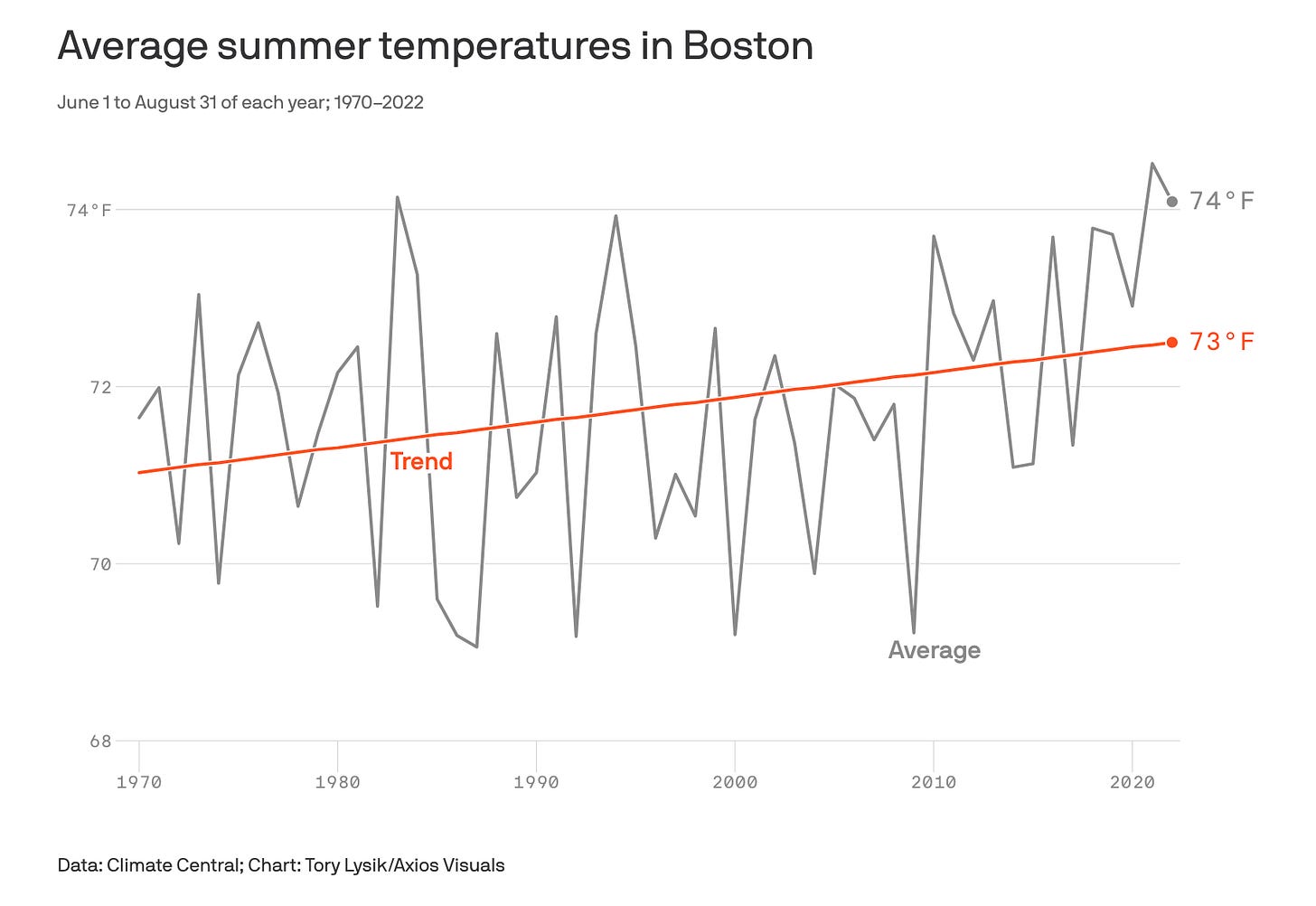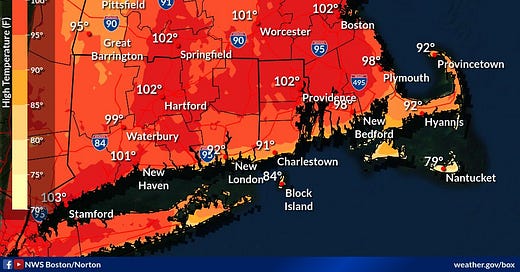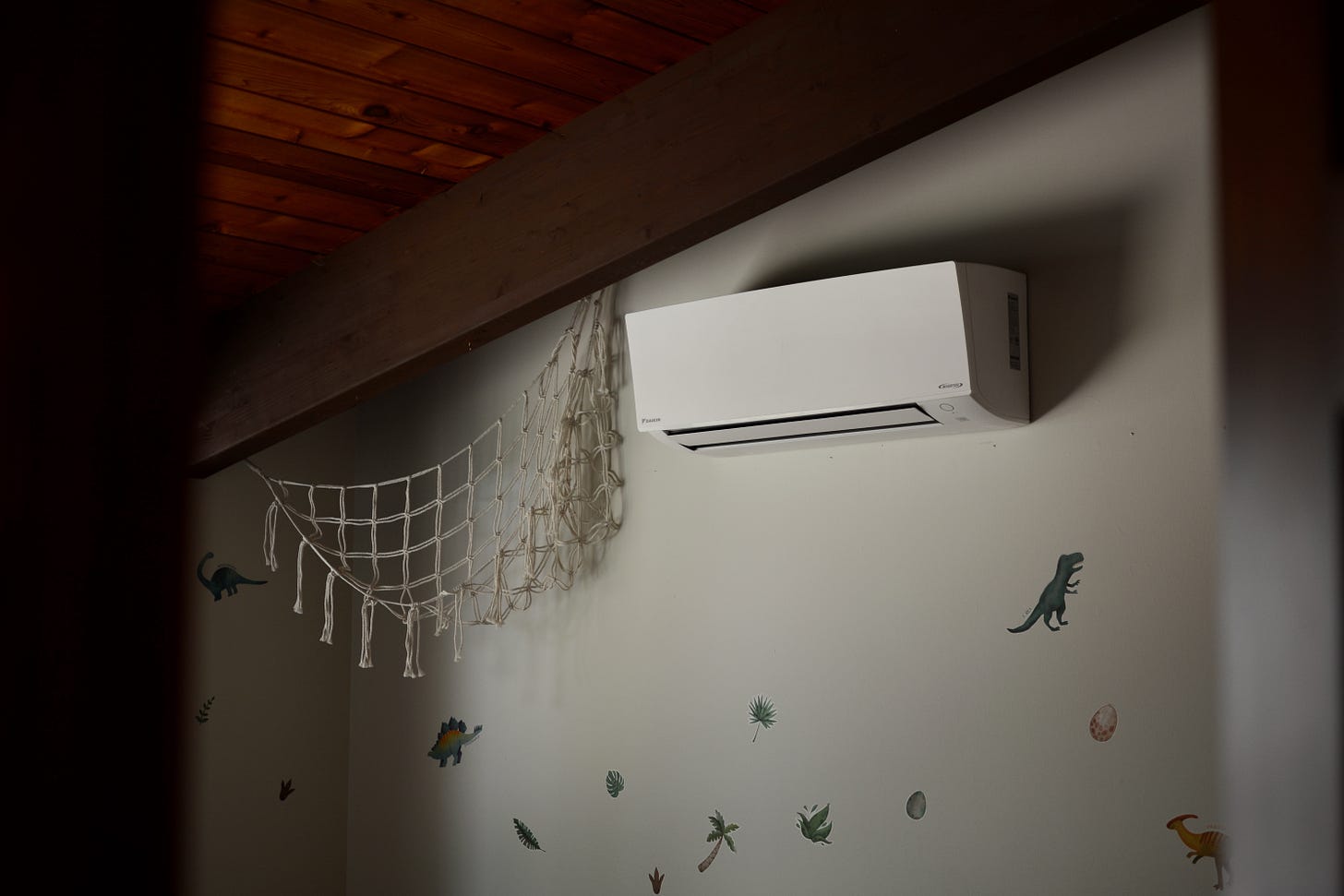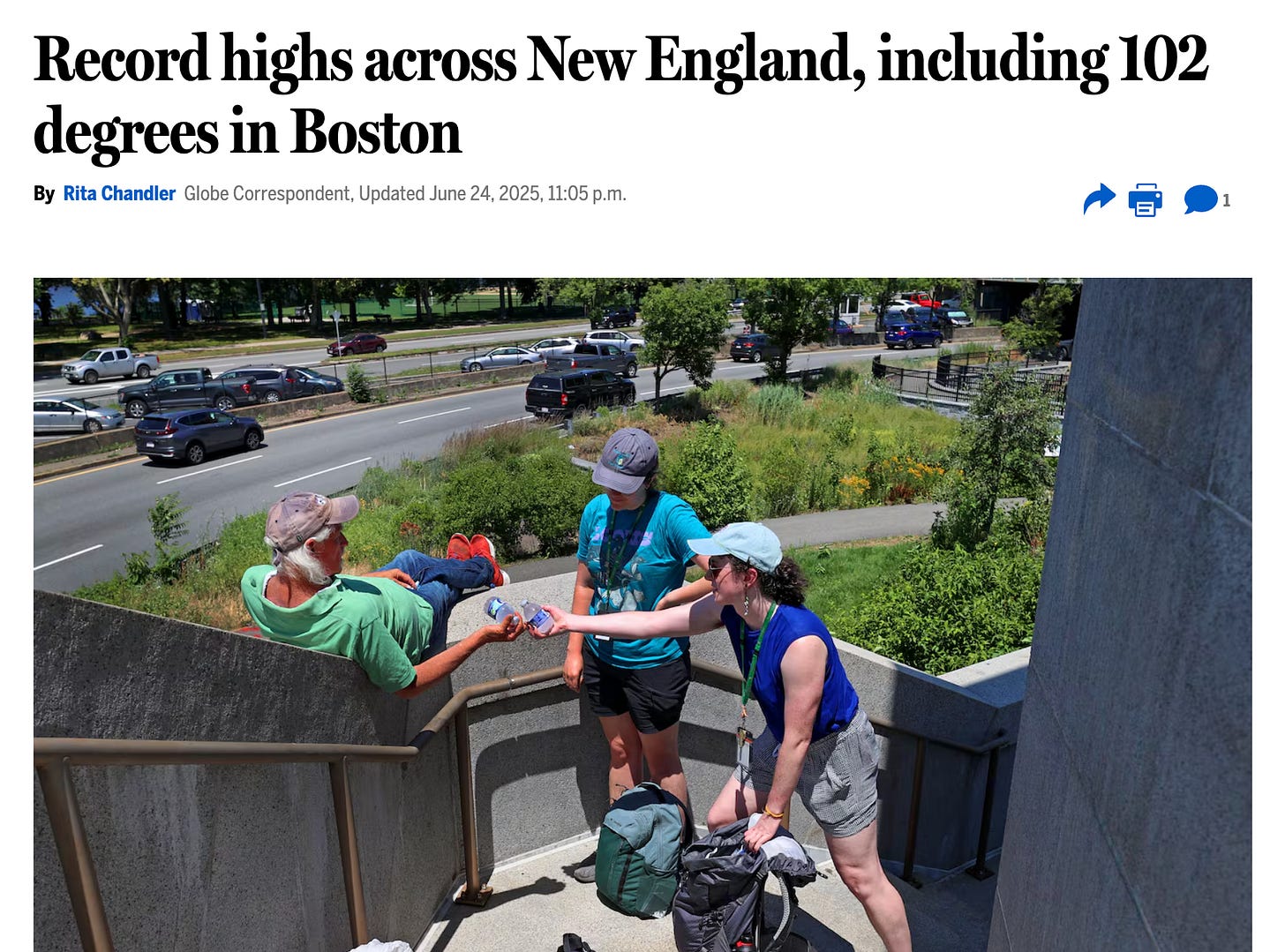Heat Pump Performance in Heat Waves
Based on a survey of LC members who installed heat pumps in their homes last year
A year after we benchmarked market prices during a heat wave, we now have the hottest day in 15 years here in the Boston Metro Area. Which, of course, is a perfect time for Laminar Collective to survey dozens of homeowners in our research newsletter about how their heat pumps performed.
This article will cover
Anonymized Responses from LC homeowners
Performance Limits & Manual J’s 1% design temperature
Our own investigation using a temperature gun in an attic!
Executive Summary
Ductless mini-splits performed better in extreme heat than ducted systems. And for homes with multiple floors, upper floors typically feel a few degrees warmer.
This checks out with submittals, such as this one for a 3-ton Mitsubishi HyperHeat unit. The SEER is highest for ductless > mixed > ducted. This is consistent across brands, and it makes logical sense: air from mini-splits don’t have to travel across ducts in a hot attic before it reaches your room.
If you have a ducted system, I would recommend:
Checking in the attic that the registers are covered by insulation.
Turning off a mini-split or 2 downstairs. This is NOT scientifically supported, we just noticed in our temperature gun walkthrough that when only one indoor unit was on (a mini-split), the discharge temp was really low.
Otherwise, given the infrequency of 90°F+ weather, a temperature on upper floors hovering around 75°F is reasonable.
Responses from Homeowners
To skip these responses & go straight to the takeaways, click here.
Colonial Single Family / Mixed Ducted + Mini-split Systems


The general takeaway is that ducted systems with an air handler in the attic, sized correctly, can struggle to hold temperatures down to 70°F when the outside temperature exceeds 100°F.
On the other hand, ductless mini-splits (typically on the 1st floor, in a mixed ductless + ducted setup) tend to hold temperature down just fine. But since cold air tends to sink, that may also have something to do with it.
There are 3 reasons for this:
Heat/cooling loss in ductwork & attic. Air has to travel through ductwork in an unconditioned attic before it reaches the rooms. The air will warm up a few degrees as it does so, particularly since the attic is so darn hot. Generally, ducted systems are less efficient than mini-split systems.
Cold air sinks. With multiple floors, sometimes the heat simply rises to the top.
Manual J’s 1% design temperature. Every city has a temperature range through the year, and heat pumps are designed for the majority of this temperature range. The hottest day in 15 years exceeds that range.
Let’s check in on each different city in the metro area:
Wakefield
My check-in for the day [Tuesday, peak of heat wave] isn’t too bad.
We got the house down to 70°F overnight to proactively combat today’s higher temps. So, aside from it being a bit too cold this morning, the temperature only crept up to 76°F at its peak. I caught it around 75°F about an hour ago.
It’s a little different from what we’re used to with the houses and systems down South, but not too bad overall—especially considering the nearly 30-degree temperature delta.
Additionally, on Wednesday:
Kinda wish the fan speed on the air handler kicked up a bit more. The square rooms centered around a central return in the hall can lead to some stuffy corners.
So far so good today. The systems seem to struggle with set points in the afternoon/early evening, but with the drop in temp, I think it'll make it today
Winchester, Split-Level SFH
Glad you're looking into this! I did have mine set to 70 (we have a youngish baby and just keeping his room as cool as possible), but I didn't expect it to get to 70 in 100 degree weather. But I guess what I expect to happen in this situation is that we would have air blowing strongly through the vents as it tries its best to meet my impossible request. Instead the air coming through felt very weak when I stuck my hand in front of the vent. The upstairs rooms didn't get above 78, but we have a well insulated house with all the windows and doors closed and started the day with the house at 70.
Then later that night, when it was 86 degrees and I was still set to 70, it was still hanging out around 78 degrees for longer than I'd have expected.
Downstairs mini splits could maintain 70-72 in their areas without issue throughout the entire day.
Jamaica Plains, Townhome
Not sure how helpful my data is but my downstairs is a mini split and my upstairs is the air handler. I am away this week so I set downstairs to 77 and upstairs to 76. The data should be free from most other variables (no cooking/ someone comes once a day to feed the cat).
Also I have Fan Speed Thermo-Off Heating/Cooling (Function 25, 27) set to Stop as the 2nd floor was overheating when the Air Handler was always on.
Here is the data from Upstairs (Air Handler set to hold 76).
The Upstairs temp sensor is pulled from Kumo cloud (it should be from the MHK2 not the return temp).
I also have an independent sensor in the upstairs bathroom so I plotted the data from there too. (This sensor updates much more frequently than the Kumo data)
I find the sensor here from the minisplit return reads higher than reality so I installed two other sensors downstairs and calculated the average. These don't interact w/ the minisplit just w/ my home automation platform. See below.
Somerville, 3-Story Single Family
Happy to share a bit of info. To sum up:
We didn't set our AC to 70. I believe the lowest we went at any point was 78.
The second floor would be able to reach this temperature (FYI, our thermostat is on the second floor).
That said, it would take some time for the second floor to reach this temperature, especially compared to the first floor. After Forge made improvements to our ductwork, the first floor ducts have been noticeably more powerful—plus, the first floor has 5 supplies and 3 returns, compared to 4 supplies and one return on the second floor. This has created a bit of a balancing act on these hot days, where we set the thermostat on the second floor, but the first floor cools down immediately while the second floor takes a while. Of course, hot air rises—that's a factor as well. But the first floor ducts are clearly more powerful.
Hope that all helps, let me know if we can provide more info.
Newton, 2-story Tudor SFH:
My system worked great.
I have a ducted upstairs and mini splits downstairs, But.. I sprang for separate condensers/zones, so my experience may not be relevant.
I also tried to keep downstairs at 78, but went as low as 68 upstairs at night and 80 during the day upstairs.
Only complaint is that for the ducted upstairs, the 2 bedrooms were way less cool than my closet and bathrooms. Maybe at least partially due to smaller spaces but I suspect that it is due to the direction of the airflow. I plan to reach out to Elephant about this to ask if this is the case and if reversing direction is difficult.
Braintree, Colonial SFH
This sounds similar to my situation. I have a 2 story colonial with ducted 1st and 2nd floor. The 1st floor has an addition that is a room with a mini split. All set to 73.
After the first day it has been blowing moderate cold air and the monitor read 78-79 for room temperature. My temperature gun has since read 68 for the air blowing out of the vents including yesterday when temps dropped to 80. I've reset the system each day1 just in case with no change.
No issues for the 1st floor ducted and mini split (maybe slightly warmer than ducted 1st floor). 1st floor ducted air is reading 58 blowing out with room temp at 73-74.
Other Multi-floor Houses (Usually Ducted/Partially Ducted)
Cambridge, Two Family
We occupy the second and third floors of a house. We had a ducted system put in on the second floor (except for one room). That one room and the one finished room on the third floor each have their own minisplits.
The mini-splits worked wonderfully in both rooms, but the ducted system did not perform well. I had the thermostat set to 72 and the temperature during the heat wave never got below 82.
I've emailed elephant about this, but wanted to let you know as well. Considering the ducted system is physically below a mini split unit that worked really well I don't think our case is 'heat rises'. As far as I can tell it is just that the ducted system is not working as well as I would expect.
Newton, Townhouse
We're in the townhouse and central ducted heat pump. Not sure if that's what you're looking for, but the system barely held at 78 degrees for the second floor bedroom. First floor was fine. We have the same issue with the previous oversized AC(4T). Now the heat pump (3.5T) seems improved but still not able to keep the temperature down to the set level.
Jamaica Plains, Multi-floor (think: Duplex)
In the heat wave I set the pump to 72F (after experimenting in increments down from 78F), and the ground floor was very comfortable. The second floor much less so. And the third was pretty warm. Not anywhere near as sweltering as it would have been without the heat pump on, though.
Yes, single zone, with the thermostat located on the ground floor in the living room.
Marlborough, 4-floor Townhome
My system has been working fine in general and I feel grateful to have it installed before this summer.
My only issue is that the higher a floor doesn’t get cool enough even though the thermostat is set up to lower.
Here a little bit of background as a reference:
My home is a town house from the 80’s and has a basement plus 3 more floors so a total of 4 floors. It also has a duct system so there were no mini splits needed.
I think the highest floor (4th floor) doesn’t cool down enough as it has a very small vent.
Somerville 2-Family, 1st Floor & Basement
I don't have the configuration you mentioned, but in case it helps distinguish between hypotheses: ducted system, we occupy the basement and first floor of a double decker. (I don't know what the neighbors upstairs had their temperature as that day.)
On Tuesday evening, thermostat was 70 (I think, maybe 72) but the temperature on the first floor (where the thermostat is) was 75. Much cooler downstairs, warm air rises presumably playing a role.
South Boston, Row Home
I have a two story row house, ducted, with the thermostat downstairs and have a flat roof/no attic. I set my temp at 72 and it maintained beautifully downstairs, as usual. And as usual, my upstairs was much hotter.
I would estimate that even with my blinds closed, upstairs was 10ish degrees warmer than down. I believe that’s to be expected for any kind of ducted system without separate up and down units. The only time my up and down are about the same temp is when I don’t have the system on during the ~3.5 blissful months every year of shoulder seasons with low utility bills!
Loving 70 today! So will my wallet.
Melrose, Victorian
Fortunately, we have unfinished and relatively spacious attic and basement areas that could accommodate new ductwork to reach every room in the house. This would give us a central air system [Mitsubishi] for heating and cooling with full zoning control.
Heat wave performance:
My system held up pretty well, all things considered. We don't like the house to be too cool, so we typically don't set it below 72-73F. Especially last Tuesday it was running all day, and the house was pleasantly cool even at peak heat (my weather app was reading 40C = 104F)
The only snag is that towards the end of the afternoon, the units are exposed to the sun, and the downstairs condenser stopped working for 2-3 hours, so we had to bring out a fan. The app tells me that the upstairs unit also stopped working for about 1h, but we didn't notice it as it was still cool upstairs. I think it was some sort of thermal overload protection (probably because >100F + running all day + direct sunlight), and the system started working again once the sun was behind the trees.
All in all, I'm expecting to work pretty well throughout the summer, assuming we won't get many more days like last Tuesday.
Andre also happens to be working at the very cool Building Decarb Coalition! You can read more about his experience here:
Takeaways & Performance Limits
Fairly consistently, we are getting feedback that the air handler cannot hold indoor 2nd floor temperatures down to 70°F on a 100°F day. That’s a 30°F temperature delta.
Let’s return to potential causes:
Heat/cooling loss in ductwork & attic
I always knew that ductless systems have higher SEER2 ratings (for cooling, whereas HSPF2 is fore heating), but the impact is ultimately the discharge temperature.
Earlier, I said:
Air has to travel through ductwork in an unconditioned attic before it reaches the rooms. The air will warm up a few degrees as it does so, particularly since the attic is so darn hot. Generally, ducted systems are less efficient than mini-split systems.
This is supported by Clint, in Cambridge, who mentioned:
The mini-splits worked wonderfully in both rooms, but the ducted system did not perform well. I had the thermostat set to 72 and the temperature during the heat wave never got below 82…
Considering the ducted system is physically below a mini split unit that worked really well I don't think our case is 'heat rises'. As far as I can tell it is just that the ducted system is not working as well as I would expect.
In our next section, we took a temperature gun and measured the discharge temp of air coming out of ceiling registers on a 2nd floor. It hovered around 60 degrees or so - a full 10/15 degrees higher than the air coming out of the mini-split downstairs.
(This was on a 86 degree afternoon, 3:30pm.)
Cold air sinks, hot air rises
This is such a well-known effect that it has its own name: the stack effect. You may wonder:
If it’s so well known, why didn’t you bake this in when you designed the system?
I suspect one reason is that Boston winters are colder than the summers are hot. Interior temp of 75° on a 100°F+ day isn’t 70°F, but it’s arguably fine - much more so than not being able to maintain heat on a deep freeze day where temperatures go near zero or negative.
Since cold air sinks, this means the mini-splits on a 1st floor need to have enough capacity to bring the heat. And if the mini-split capacity is higher, then you’d get more powerful cooling, too.
Manual J’s 1% design temperature
Every city has a temperature range through the year, and heat pumps are designed for the majority of this temperature range. The hottest day in 15 years exceeds that range.
Hear it straight from Ed Janowiak, ACCA’s Manager of HVAC Design Education:
I can either make you happy 1% of the year, or 99% of the year. Which would you prefer?
Here’s the 1% design temperature for the Boston metro area: 90°F.
It’s true, you can get more cooling capacity out of a heat pump if you oversize it & have a 3-ton air handler in the attic. Such a system can maintain 70°F on a 100°F+ day, but it would be inefficient on a mild day due to short-cycling (when the AC turns on, overshoots the target temp, then off, then on, then off, etc) & lack of dehumidification.
Finally, take a look at this set point used for system sizing:
75 degrees. For all of these reasons, I think it’s reasonable to conclude that it’s quite normal for upstairs ducted systems to struggle a bit on the hottest days in a decade.
It also probably means that ACCA should update their temperature guidance (the latest version is 2021, I think?) to reflect projections for a hotter summer, in a hotter world.

Climbing into a Hot Attic to Verify Heat Loss
Okay, how do I know there’s heat loss in an attic for sure? I climbed into a hot attic to find out. This was Monday, June 30th, a sunny 87°F day at around 3:30PM, peak heat.
You’ll notice that the coldest areas is the space underneath the ductwork, and the air handler itself:
15 minutes before this video, LC co-founder Hannan walked up there and found that the supply registers were not covered in blown-in insulation. We partly showed up to this house to diagnose why the 2nd floor wasn’t holding temperature; when we pointed the temperature gun, the uninsulated boot was around 82 degrees.
It shouldn’t be surprising that the discharge temperature dropped from 68 → 62 immediately after we pushed insulation over the supply register box.
Conclusion
Going forward, we are going to make it a lot more clear to people that there is a tradeoff not only between aesthetics & efficiency when it comes to ducted 2nd floors, but aesthetics & comfort. This is particularly so when our summers are getting warmer, and the heat pumps being installed are supposed to last 15+ years with good maintenance.

By the end of the lifetime of these systems, we are projected to have somewhere closer to 30 to 40 days of 90°F days.
Now, this is a heat pump research blog, not a climate blog. But it is literally impossible for me to do my job without considering that we’re going to have higher temperatures in the future. So as the Senate passes the reconciliation bill that will ax renewable energy deployment in the years to come, I want you all to be aware that the summers are on track to be hotter in the coming years.
At least it makes you feel pretty good about having AC, doesn’t it?
Note: “During and currently, the 2nd floor ducted floor is not blowing cold air. First day of heat wave it also wasn't blowing any cold air so I had to turn off the whole system at the electrical panel to reset it and it started blowing air.” And here’s a follow-up:
I did send a message to elephant support last night.
I did have this situation switch the first time we had a warm weekend here where my 1st floor just blew at 68 with room temp at 80. 2nd floor blew cold air and reached room temp of 73-74. They did a visit and they said the fix was some switch they had to turn on that I could not access. They said this switch isn't always turned on because sometimes the system works with it off. This sounded unusual to me.
















